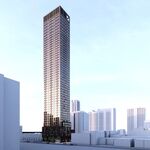It's the Parking, Stupid: One Transportation Consultant's Tough Love Approach
Read More: http://www.theatlanticcities.com/commute/2011/10/its_parking_stupid/323/
.....
The Atlantic Cities had 20 minutes to spare this week at the Rail~Volution conference in Washington, where Tumlin was preaching some of his painful parking innovation. And so we asked for the full story. Tumlin starts with another great metaphor: What would happen if we gave all children free ice cream? They would, undoubtedly, be thrilled. But in the process we’d also be creating obesity, driving up the price of milk, and probably causing a cheese shortage. “And just as it would be very bad economic and social policy to provide free ice cream for all children,” Tumlin says, “it is also bad to provide free parking for all motorists.”
- In his search for parking policy that truly reflects the market demand and value of a 9-by-20-foot strip of asphalt, Tumlin sounds a lot like an economist. In fact, he thinks we’d be better off thinking of transportation as a branch of economics rather than engineering. For years, cities have told people that they have to pay for parking meters to create more money for general funds, as if those quarters were a kind of tax. That logic obscures the fact that people should pay for parking because parking in and of itself has a cost – and because by charging for parking, cities create parking availability, which is the real commodity.
- And because people tend to highly value their time, they’re generally happier to pay more for a parking spot right in front of a store than to pay less for a spot that requires 10 minutes of circling. This makes customers happier, and it also facilitates a larger number of people – some of whom now come on bike or transit – getting in and out of a popular shopping district. When cities raise parking prices in partnership with local businesses, they can explain that such policies exist to create more successful commercial districts. And the city as a whole, Tumlin says, is going to make a lot more money off having successful commercial districts than it ever will off of its parking meters.
- Technology, meanwhile, can take advantage of changes in supply and demand by the hour, or the season, or even according to swells in the national economy, adjusting parking rates according to real-time availability. San Francisco is rolling out such a strategy this month. All of this technology is making it easier to address parking pricing. But the technology has also been around for a few years, even as old assumptions about parking have continued to persist. “Technology,” Tumlin says, “has made it even more embarrassing for the cities that are badly managing their parking.”
- As these systems move parking toward a more market-responsive approach, Tumlin also has his eye on distortions such as the free parking given at disabled spaces. “Disabled people,” he says, “don’t need to have their parking subsidized unless they are low-income and disabled.” It makes no sense, he adds, to give free parking to a disabled doctor or lawyer. But we’re not very good, Tumlin says, at having grown-up conversations about how to accommodate people with disabilities. Washington, D.C., will test this idea later this year with an everyone-pays policy (which will require, among other things, some newly designed parking meters).
- Tumlin commonly hears one other objection to his ideas: Where will the poor people park? The poorest people, he’s found, aren’t looking for parking because they don’t own cars. But among the rest of this demographic, he says surveys show that poor people also place an extremely high value on their time. They too often say they’re willing to pay a little more for parking if it means they don’t have to waste time looking for it. “It’s very interesting to do the detailed demographic surveys and ask people what they want,” he says. “And what we find again and again is that the people who are complaining about ‘oh my goodness, where will the poor people park?’ are not the poor people.”
.....





